|
|
|
Sort Order |
|
|
|
Items / Page
|
|
|
|
|
|
|
| Srl | Item |
| 1 |
ID:
082933
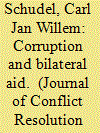

|
|
|
|
|
| Publication |
2008.
|
| Summary/Abstract |
Corruption in developing states reduces the effectiveness of foreign aid that is allocated to them, because government officials in corrupt countries use this money for private rather than public purposes. Despite this, existing studies do not find different aid policies from donor governments toward corrupt and less corrupt recipients. However, most of these studies have not taken account of variation among donor states. This is an important omission, because donor states behave differently. This article argues that the responsiveness of donor states to corruption in recipient states depends on their own level of corruption: less corrupt donor states allocate more aid to less corrupt recipient states than to corrupt recipients, whereas corrupt donor states do not make such a clear distinction. This proposition is tested by both pooled ordinary least squares and fixed effects estimations. The data support the argument that corruption levels in donor states determine their reaction to corruption in recipient states.
|
|
|
|
|
|
|
|
|
|
|
|
|
|
|
|
| 2 |
ID:
082932
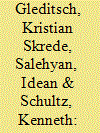

|
|
|
|
|
| Publication |
2008.
|
| Summary/Abstract |
Although research on conflict has tended to separately study interstate conflict and civil war, states experiencing civil wars are substantially more likely to become involved in militarized disputes with other states. Scholars have typically focused on opportunistic attacks or diversionary wars to explain this domestic-international conflict nexus. The authors argue that international disputes that coincide with civil wars are more often directly tied to the issues surrounding the civil war and emphasize intervention, externalization, and unintended spillover effects from internal conflict as important sources of international friction. They empirically demonstrate that civil wars substantially increase the probability of disputes between states. An analysis of conflict narratives shows that the increased risk of interstate conflict associated with civil wars is primarily driven by states' efforts to affect the outcome of the civil war through strategies of intervention and externalization and not by an increase in conflicts over unrelated issues.
|
|
|
|
|
|
|
|
|
|
|
|
|
|
|
|
| 3 |
ID:
090992


|
|
|
|
|
| Publication |
2009.
|
| Summary/Abstract |
The literature suggests that geographically concentrated groups face a higher likelihood of conflict. While this finding seems to be commonly accepted, there is no clear consensus that explains why this is the case. Two competing mechanisms have been proposed: first, a motivation-driven mechanism, where the existence of a well-defined group territory makes the group more likely to fight for it; and second, an opportunity-driven link, where concentration facilitates group coordination for collective action. This article aims to resolve this controversy by developing new settlement pattern indicators based on Geographic Information Systems (GIS) data. Using conflict data at the level of ethnic groups, I show that there is clear evidence in favor of the opportunity mechanism. Thus, the effect of group concentration on conflict seems to be driven by the strategic advantages for group coordination that the spatial proximity of group members provides.
The literature suggests that geographically concentrated groups face a higher likelihood of conflict. While this finding seems to be commonly accepted, there is no clear consensus that explains why this is the case. Two competing mechanisms have been
|
|
|
|
|
|
|
|
|
|
|
|
|
|
|
|
| 4 |
ID:
082936
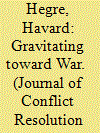

|
|
|
|
|
| Publication |
2008.
|
| Summary/Abstract |
Countries have better abilities and stronger incentives to engage in militarized conflicts the larger and more powerful they are. The article applies Zipf's notion of a ``gravity model'' to the risk of interstate conflict and argues that the empirical relationship between size and distance and conflict is stronger than any other identified in dyadic statistical studies of interstate conflict. Most empirical studies of interstate conflict fail to take size properly into account. The article shows that controlling for size variables improves the estimation of other variables of interest, and it explores the impact of omitting size variables for the investigation of the power preponderance versus power parity debate. The results indicate that even though a power capability ratio variable suggests asymmetric dyads are less conflict-prone, the risk-increasing effect of power itself means that a unilateral increase of power in one country increases the risk of conflict
|
|
|
|
|
|
|
|
|
|
|
|
|
|
|
|
| 5 |
ID:
082935
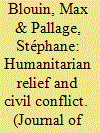

|
|
|
|
|
| Publication |
2008.
|
| Summary/Abstract |
The authors examine the effects that famine relief efforts (food aid) can have in regions undergoing civil war. In the model, warlords seize a fraction of all aid entering the region. How much they can loot affects their choice of army size; therefore the manner in which aid is delivered influences warfare. The authors identify a delivery plan for aid that minimizes total recruitment in equilibrium
|
|
|
|
|
|
|
|
|
|
|
|
|
|
|
|
| 6 |
ID:
082937
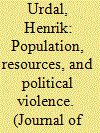

|
|
|
|
|
| Publication |
2008.
|
| Summary/Abstract |
Recent cross-national studies have found only moderate support for the idea that population pressure and resource scarcity may lead to political violence, contrary to much of the case study literature in the field. This article suggests that the level of analysis may be at the heart of this discrepancy. In a time-series study of political violence in 27 Indian states for the 1956-2002 period, it is tested whether high population pressure on renewable natural resources, youth bulges, and differential growth rates between religious groups are associated with higher levels of armed conflict, political violent events, and Hindu-Muslim riots. The results are generally more supportive of the resource scarcity and conflict scenario than recent global studies. The article further suggests that youth bulges affect all three forms of violence and that differential growth rates are positively related to armed conflict.
|
|
|
|
|
|
|
|
|
|
|
|
|
|
|
|
| 7 |
ID:
082934
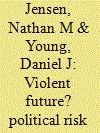

|
|
|
|
|
| Publication |
2008.
|
| Summary/Abstract |
There is a substantial literature that has linked past acts of violence to investment. In this article, we argue that the appropriate mechanism linking violence to investment is investor perceptions of risk, in which forward-looking investors attempt to predict the likelihood of future political violence. We take advantage of a new data source-the price paid by investors to purchase risk insurance coverage-to more accurately capture how risk is assessed in investment decision making. Building on the civil war literature, we offer a broad explanatory model of variation in violence risk in the developing world. After controlling for recent past experiences with violence, we find that wealth and democracy significantly affect the perception of risk, whereas demographic factors and natural resource endowments have limited, if any, influence.
|
|
|
|
|
|
|
|
|
|
|
|
|
|
|
|
|
|
|
|
|